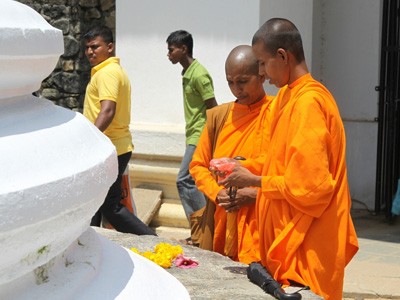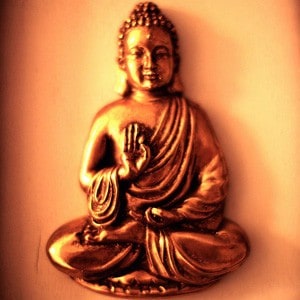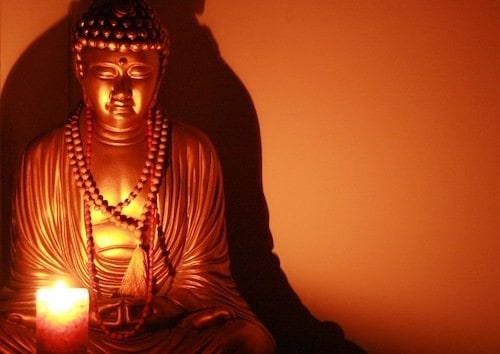The Bhikshuni Order in Theravada Sri Lanka

An interview with Venerable Omalpe Sobhita Thero, Founder-President of Sri Bodhiraja Foundation (Sri Lanka) and Religious advisor, Bodhiraja Buddhist Society (Singapore). In this article, Venerable Omalpe Sobhita Thero, one of the most vocal proponents for the restoration of the Bhikshuni order in Sri Lanka, shares with us his thoughts and hope.
Question: Can you brief us on its history?
Venerable Omalpe Sobhita Thero (VOST): In the 3rd century AD, the Bhikshuni order was established in Sri Lanka with the arrival of Bhikshuni Sanghamitta from India who brought with her a sapling of the sacred Bo tree under which the Buddha attained enlightenment. The first Sri Lankan woman to be ordained was Bhikshuni Arula. For about 1200 years thereafter, the Bhikshuni order in Sri Lanka flourished. At its height, the Hatthalhaka Mehanivara at Anuradhaphura had more than 1000 Bhikshunis. In 1017 AD, the Cholas from South India invaded Sri Lanka, dealing a death blow to Buddhism. Many monks and Bhikshunis were killed or forced to flee. As a result, the Bhikshuni order in Sri Lanka disappeared. Unlike the monks order which was later restored with the invitation of monks from Burma, there were no Bhikshuni in the other Theravada countries. Thus it is argued that proper ordination could not be held, and that the Bhikshuni order declared extinct.
In recent years, there has been growing debate about the restoration of the Bhikshuni order in Theravada countries. However, despite some progress, the revival of the Bhikshuni order has being a slow and difficult one. In comparison to the successful development of the Bhikshuni order in Mahayana traditions such as in Taiwan where well-educated and active nuns have carved a niche for themselves in what was traditionally a patriarchal domain, the Bhikshuni order in Sri Lanka is struggling to find its feet.
Question: What is the current situation of the Bhikshuni order in the Theravada Sri Lanka?
VOST: Let me start by first making a distinction between Bhikshuni and dasasilmatas. To be a Bhikshuni, one has to be fully ordained by a group of monks and nuns and conduct onself according to the Vinaya. In Sri Lanka, we have what are called “dasasilmatas”, women who observe the ten precepts. But they are strictly speaking not Bhikshunis. There is no formal organization of the dasasilmatas, and no uniformity in the way they dresse. For example, some wear white costumes while others wear yellow. Many of these dasasilmatas practiced under loose guidance as there are few educational centres for Bhikshunis.
In the 90s, with influence of feminist movements in the West, some groups of women and dasasilmatas demanded establishment of Bhikshuni order. This led to much debate among the chief monks of the different nikayas (sects). Rejecting the women’s demand, they argued that there is really no provision in the Vinaya for the reestablishment of a Bhikshuni sangha that has disappeared from Sri Lanka around 11th C AD.
On the other hand, there were groups of more progressive monks who supported the women. They argued that since Sri Lankan Bhikshunis migrated to East Asia in the 7th C AD, the lineage was continued. Hence the Bhikshuni order can be restored with the help of Bhikshunis from countries such as China and Korea.
The most significant event of the restoration of the Bhikshuni order in the Theravada tradition in recent years was the Bhikshunis ordination at Saranath in India in 1998. The ordination was conducted by a group of monks and Korean Bhikshunis. After almost 1000 years, the Bhikshuni order was revived in India. At this historic event, 11 dasasilmatas from Sri Lanka were ordained. These Bhikshunis returned to Sri Lanka and in the following year, they ordained another 23 dasasilmatas, reviving the Bhikshuni tradition in Buddhism’s chosen land.
However, the opposition from the conservatives in the sangha remained strong. Although there are currently about 500 higher ordained Bhikshunis in Sri Lanka, the controversy continues as the hierarchy of monks still do not receive or welcome this order. Rather they view the Bhikshuni order as a separate sect. In fact, among the dasasilmatas and women organizations, there is no one agreement about the Bhikshuni order. Even among the Buddhist laity, there are also divided views on the issue.
Question: What is the legal status of bhikksunis compared to that of the bhikkhus?
VOST: Monks in Sri Lanka are required by law to be registered with the Ministry of Religious Affairs. They are given identity cards and receive much support from the government in education and other areas.
The Government of Sri Lanka is advised by the highest authority of the four Nikayas on Buddhist affairs. As these chief monks have not given their sanction to the ordination of the Bhikshunis, the Bhikshuni order remains in limbo.
Question: What does the lack of legal recognition imply for the Bhikshunis?
VOST: Although the Bhikshunis enjoy a fair amount of freedom in their practice and support from the people, they are not recognized legally. There is no registration of Bhikshunis. Hence there are also no clear cut statistics on the number of dasasilmatas and Bhikshunis in Sri Lanka. Without legal recognition by the Sri Lankan government, the movement has no proper grounding. The current situation is not desirable. Without legal sanction and any authority to set the guidelines, the Bhikshuni order has no clear direction. Sometimes, people are confused and do not know how to relate to them, whether as dasasilmatas or Bhikshunis, since they may be dressed similarly. If this unhealthy trend persists, it will only create more factions within the already divided Buddhist community. There are also many anti-Buddhist forces at work. Any further division will create opportunities for these forces to further undermine Buddhism and threaten its future.
Question: Is the restoration of the Bhikshuni order necessary?
VOST: The Buddha declared four pillars of Buddhism—bhikkhus, bhikshunis, upasikas, and upasakas. Only when all four are well established can Buddhism thrive and flourish. For the well being of Buddhism and society at large, the proper restoration of the Bhikshuni order is very essential.
Women make up half the world’s population and a big force in society. In Taiwan, I was impressed by what the Bhikshunis are doing, not just in propagating the Dhamma but in social work. The foremost example is Venerable Cheng Yan, founder of Tzu Chi Foundation.
Bhikshunis can play a very important role in areas where it may be inconvenient for monks, especially in the area of counseling and health care. In the case of Sri Lanka, many mothers leave their homes to work abroad, leaving their children behind. There are many cases of young girls being raped or molested by their fathers or uncles but they are too afraid to tell their friends, teachers or doctors. Bhikshunis can fill the gap here in providing counseling services and even in the provision of a safe haven for these troubled girls. A well established and recognized Bhikkhsuni sangha can be organized as a potential force to arrest the social situation.
Question: Granted the importance of a well established Bhikshuni order, what can be done to lift the status quo of the Bhikshuni order?
VOST: There is no one simple straightforward answer. But we must start with openness and frankness. We must all agree that there is a need to establish a proper system for the Bhikshuni order. There are a few things which need to be done, all at the same time.
Firstly, we need to establish a platform for dialogue among scholars, monks, Bhikshunis, Buddhist activists and all parties concerned. We need to persuade the conservatives that a proper organized Bhikshuni order will add strength to the Buddhist sasena.
Second, we need to establish proper disciplinary guidelines for the Bhikshunis, set up some form of a council which will formulate the rules and regulations for the order, particularly to distinguish between Bhikshunis and dasasilmatas.
Thirdly, we need to empower the dasasilmatas and existing Bhikshunis with more skills and knowledge. We need to provide adequate and systematic training, not just in the Dhamma but social works such as counseling and health care. Only then can the Bhikshunis effectively perform their religious and social services. Through engagement in social work, there will be greater public awareness and acceptance among the people.
Lastly, when people themselves realize the enormous contribution that Bhikshunis can make to society, we can find support for a demand to accord legal status to the Bhikshuni order.
Question: Are you optimistic about the development of a strong Bhikshuni order in Sri Lanka?
VOST: I would say neither optimistic nor pessimistic, but realistic. I think there is no other way to go. Whether legal or not, the Bhikshuni order is already there. What we must do is to ensure that this newborn child is well nourished and cared for and with the proper guidance realize her full potential to benefit the whole of all humanity.


